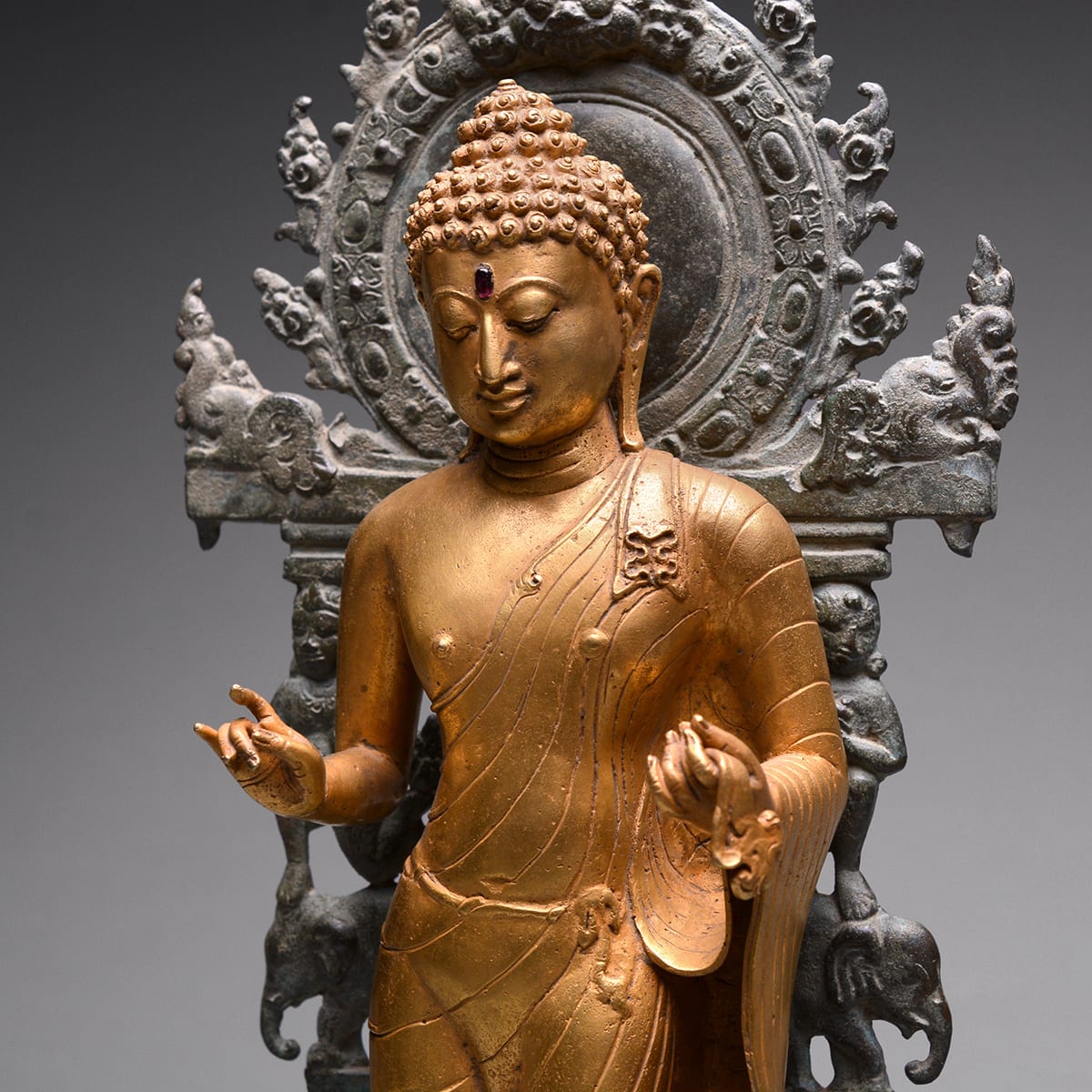Indonesian Gold Sculpture of Buddha with a Bronze Base, 11th Century CE - 14th Century CE
Gold, Bronze, Ruby
33.7 x 13.3 cm
13 1/4 x 5 1/4 in
13 1/4 x 5 1/4 in
CK.0110
Further images
Like much of Southeast Asia, the island of Java (today a part of the archipelago nation of Indonesia) has historically been highly influenced by Indian civilization. The religions of Hinduism...
Like much of Southeast Asia, the island of Java (today a part of the archipelago nation of Indonesia) has historically been highly influenced by Indian civilization. The religions of Hinduism and Buddhism, both originating from the subcontinent, were the vehicles through which Indian culture spread across Java and the greater archipelago region. However, due to its location near the strategic Straights of Malacca, one of the most important maritime routes in the world, Java was also exposed to many other cultural influences. As Buddhism began to spread in China, Chinese pilgrims would often stop in Java en route to the holy sites in India. Like other cultures exposed to foreign influences, the Javanese did not practice wholesale assimilation, but instead opted to pick and choose certain elements that appealed to their tastes, incorporating them into their own culture, while altogether ignoring other aspects.
Before the spread of Islam into the archipelago beginning in the 13th century and the rise of various Muslim states in the following centuries, Hinduism and Buddhism flourished in Java and beyond. Even after the majority of Java converted to Islam, certain Hindu customs and beliefs persisted among the greater population. While Hinduism and Buddhism share several similarities, the type practiced in Java was syncretic, combining certain features with native traditions. Hindu and Buddhist maritime kingdoms began to emerge on the archipelago at the end of the first millennium. Srivijaya was perhaps the most dominant. Although based in Sumatra, the Srivijaya Kingdom was allied with the Buddhist Saliendra Dynasty (the builders of Borobudur, the largest Buddhist structure in the world) who controlled Java. As the power of the Saliendras began to wane, a rival Indianized kingdom began to take over. Known as the Matarams, from their base in Central Java, this kingdom quickly rose to prominence, becoming a serious rival to Srivijaya hegemony.
The historical figure, Buddha Gautama Sakyamuni is the Buddha of compassion who, having achieved the highest evolutionary perfection, turns suffering into happiness for all living beings. Born around 560 B.C. somewhere between the hills of south Nepal and the Rapti river, his father was a Raja who ruled over the northeastern province of India, the district including the holy Ganges River. The young prince was married to Yashoda when he was about 17 years old and together they had a son named Rahula. At the age of 29, he left his life of luxury, as he felt compelled to purify his body and make it an instrument of the mind by ridding himself of earthly impulses and temptations.
Before the spread of Islam into the archipelago beginning in the 13th century and the rise of various Muslim states in the following centuries, Hinduism and Buddhism flourished in Java and beyond. Even after the majority of Java converted to Islam, certain Hindu customs and beliefs persisted among the greater population. While Hinduism and Buddhism share several similarities, the type practiced in Java was syncretic, combining certain features with native traditions. Hindu and Buddhist maritime kingdoms began to emerge on the archipelago at the end of the first millennium. Srivijaya was perhaps the most dominant. Although based in Sumatra, the Srivijaya Kingdom was allied with the Buddhist Saliendra Dynasty (the builders of Borobudur, the largest Buddhist structure in the world) who controlled Java. As the power of the Saliendras began to wane, a rival Indianized kingdom began to take over. Known as the Matarams, from their base in Central Java, this kingdom quickly rose to prominence, becoming a serious rival to Srivijaya hegemony.
The historical figure, Buddha Gautama Sakyamuni is the Buddha of compassion who, having achieved the highest evolutionary perfection, turns suffering into happiness for all living beings. Born around 560 B.C. somewhere between the hills of south Nepal and the Rapti river, his father was a Raja who ruled over the northeastern province of India, the district including the holy Ganges River. The young prince was married to Yashoda when he was about 17 years old and together they had a son named Rahula. At the age of 29, he left his life of luxury, as he felt compelled to purify his body and make it an instrument of the mind by ridding himself of earthly impulses and temptations.







